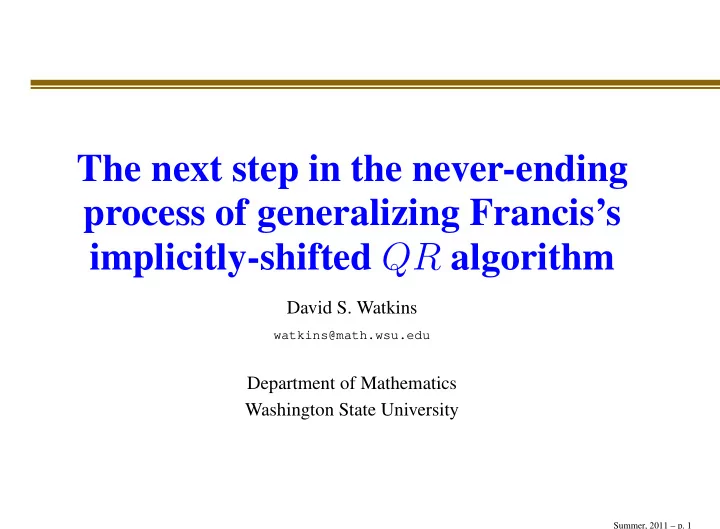

� � � � � � � � � � � � � � � � � � � � Summer, 2011 – p. 38
� � � � � � � � � � � � � � � � � � Summer, 2011 – p. 39
� � � � � � � � � � � � � � � � � � Summer, 2011 – p. 40
� � � � � � � � � � � � � � � � � � Summer, 2011 – p. 41
� � � � � � � � � � � � � � � � � � Summer, 2011 – p. 42
� � � � � � � � � � � � � � � � � � Summer, 2011 – p. 43
� � � � � � � � � � � � � � � � � � Summer, 2011 – p. 44
� � � � � � � � � � � � � � � � � � Summer, 2011 – p. 45
� � � � � � � � � � � � � � � � � � Summer, 2011 – p. 46
� � � � � � � � � � � � � � � � � � Summer, 2011 – p. 47
� � � � � � � � � � � � � � � � � � Now go the other way. and so on ... Summer, 2011 – p. 47
Comparing start with finish � � � � � � � � � � � � � � � � � � � � � � � � � � � � � � � � Pattern moves upward by one. Summer, 2011 – p. 48
Two ways to finish � � � � � � � � � � � � � � � � � � � � � � � � � � � � � � � � Bottom rotator can be on left or right. Summer, 2011 – p. 49
Does it work? Summer, 2011 – p. 50
Does it work? Raf tried it out. Summer, 2011 – p. 50
Does it work? Raf tried it out. It works great! Summer, 2011 – p. 50
Does it work? Raf tried it out. It works great! Can we establish some convergence theory? Summer, 2011 – p. 50
Does it work? Raf tried it out. It works great! Can we establish some convergence theory? Yes, we can! Summer, 2011 – p. 50
Does it work? Raf tried it out. It works great! Can we establish some convergence theory? Yes, we can! multishift iterations of any degree Summer, 2011 – p. 50
What is Francis’s algorithm? Summer, 2011 – p. 51
What is Francis’s algorithm? It’s nested subspace iteration ... Summer, 2011 – p. 51
What is Francis’s algorithm? It’s nested subspace iteration ... with changes of coordinate system. Summer, 2011 – p. 51
What is Francis’s algorithm? It’s nested subspace iteration ... with changes of coordinate system. No reliance on implicit- Q theorem. Summer, 2011 – p. 51
What is Francis’s algorithm? It’s nested subspace iteration ... with changes of coordinate system. No reliance on implicit- Q theorem. DSW, A M Monthly (May 2011) Summer, 2011 – p. 51
What is Francis’s algorithm? It’s nested subspace iteration ... with changes of coordinate system. No reliance on implicit- Q theorem. DSW, A M Monthly (May 2011) Summer, 2011 – p. 51
What is Francis’s algorithm? It’s nested subspace iteration ... with changes of coordinate system. No reliance on implicit- Q theorem. DSW, A M Monthly (May 2011) Check this out! Summer, 2011 – p. 51
What is Francis’s algorithm? Summer, 2011 – p. 52
What is Francis’s algorithm? It’s nested subspace iteration ... Summer, 2011 – p. 52
What is Francis’s algorithm? It’s nested subspace iteration ... on Krylov subspaces. (from Hessenberg form) Summer, 2011 – p. 52
What is Francis’s algorithm? It’s nested subspace iteration ... on Krylov subspaces. (from Hessenberg form) � span { e 1 } � � span { e 1 , Ae 1 } � � � e 1 , Ae 1 , A 2 e 1 � span � � � e 1 , Ae 1 , A 2 e 1 , A 3 e 1 � span � Summer, 2011 – p. 52
What is Francis’s algorithm? It’s nested subspace iteration ... on Krylov subspaces. (from Hessenberg form) � span { e 1 } � � span { e 1 , Ae 1 } � � � e 1 , Ae 1 , A 2 e 1 � span � � � e 1 , Ae 1 , A 2 e 1 , A 3 e 1 � span � For other forms, adjust the Krylov subspaces Summer, 2011 – p. 52
Recommend
More recommend